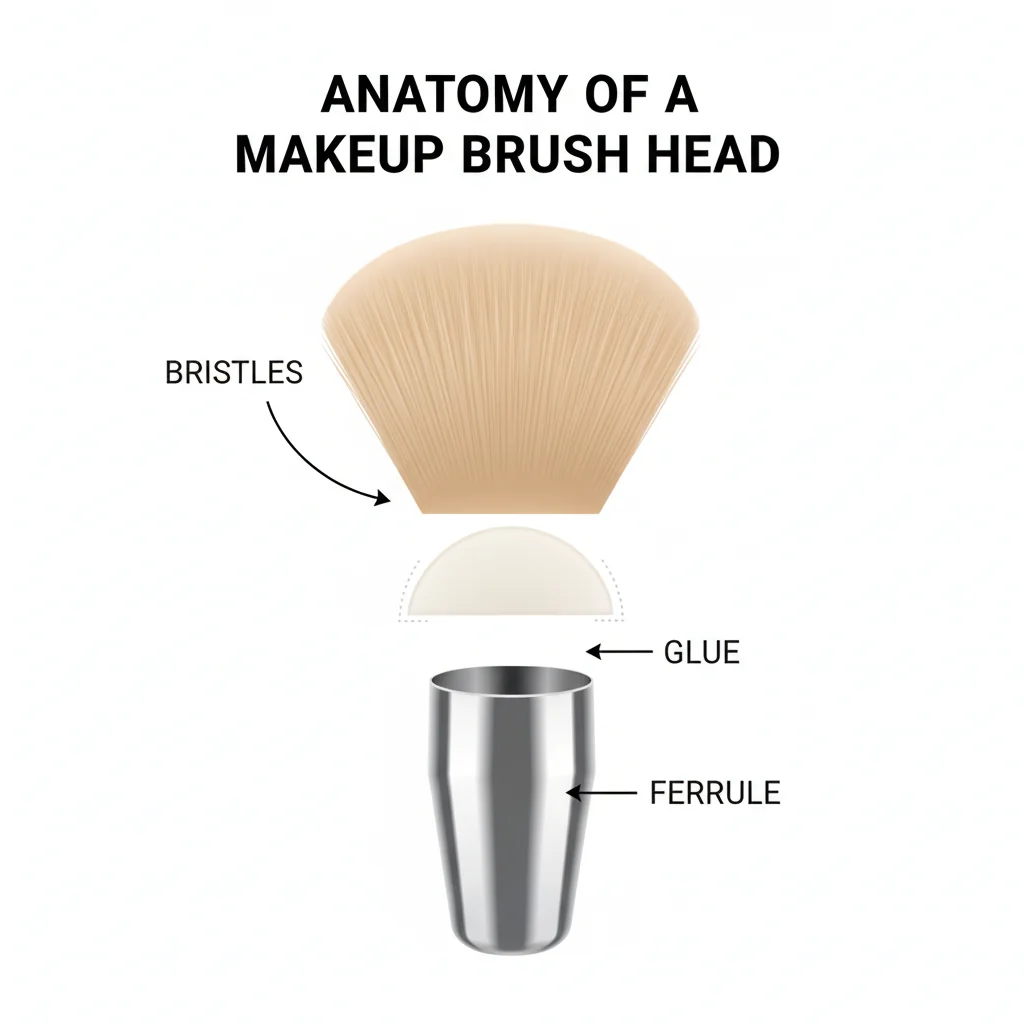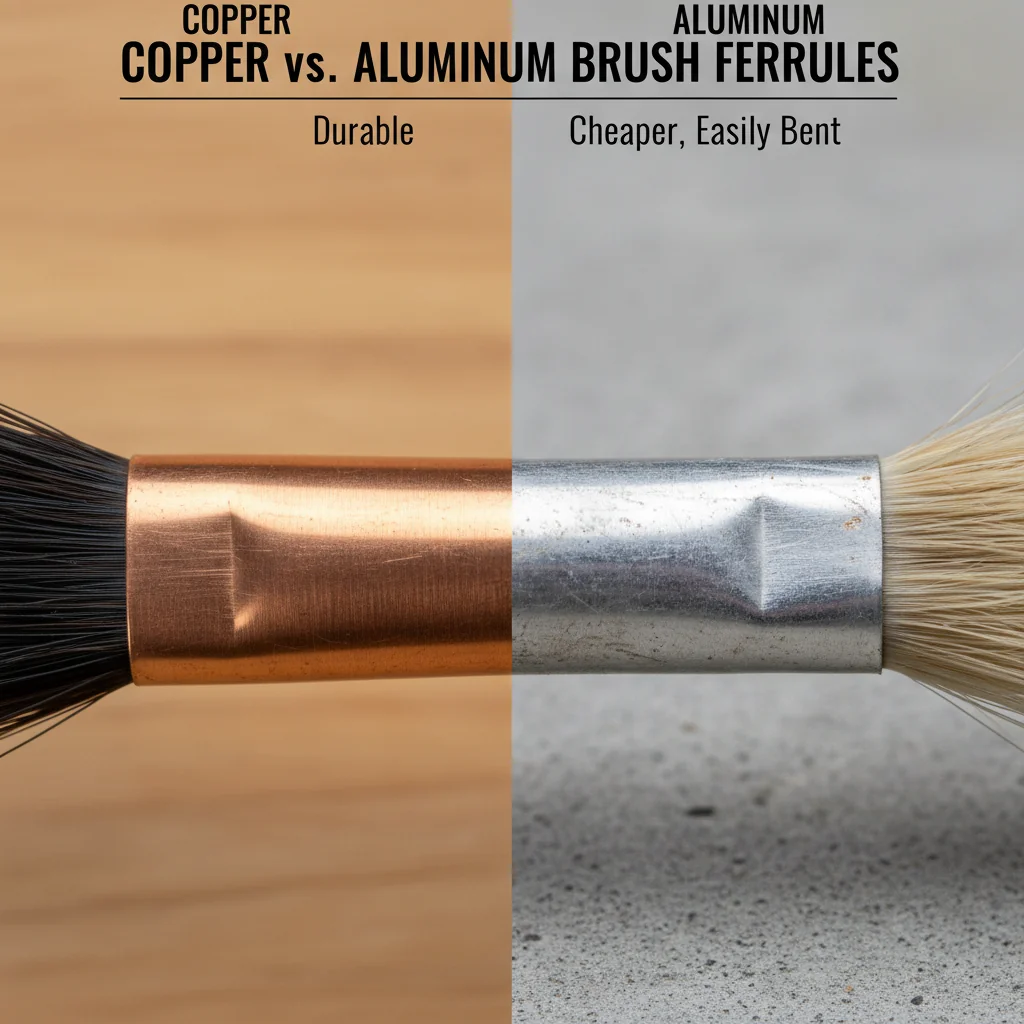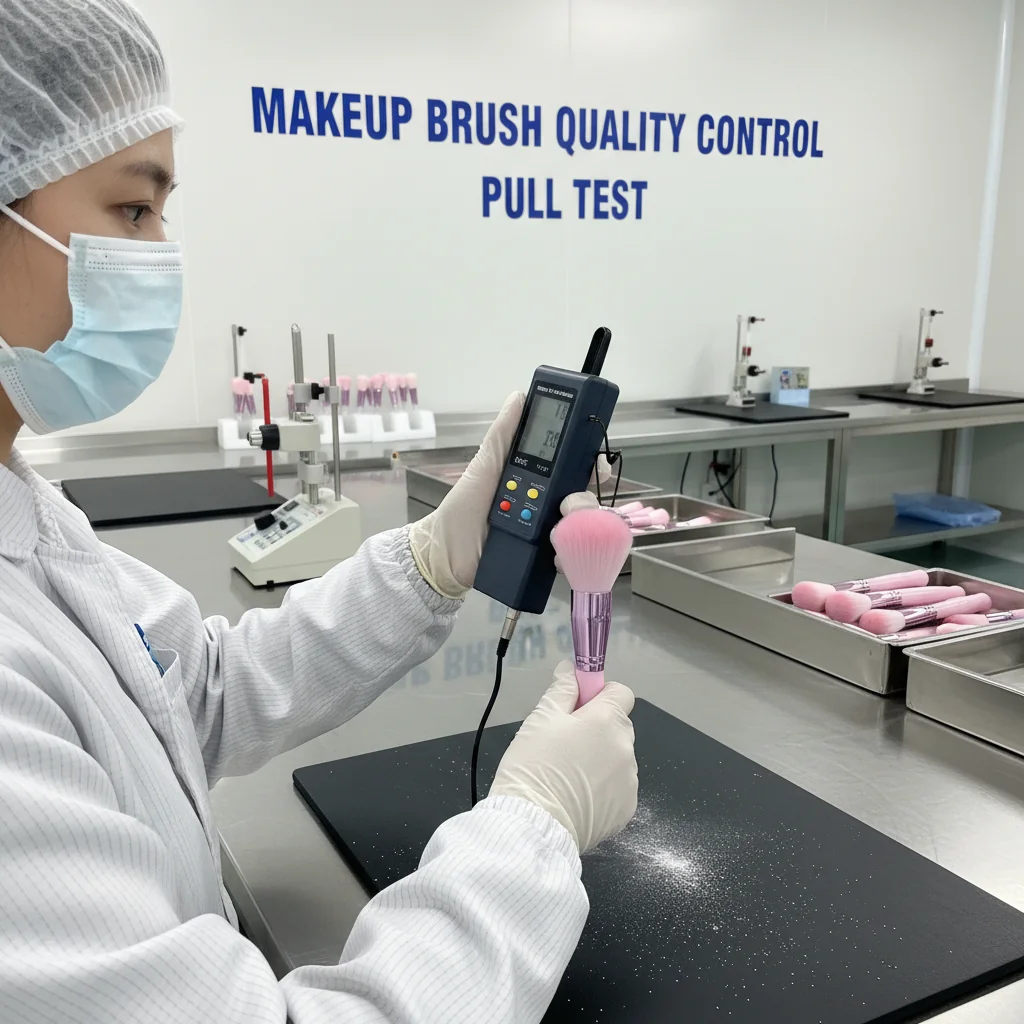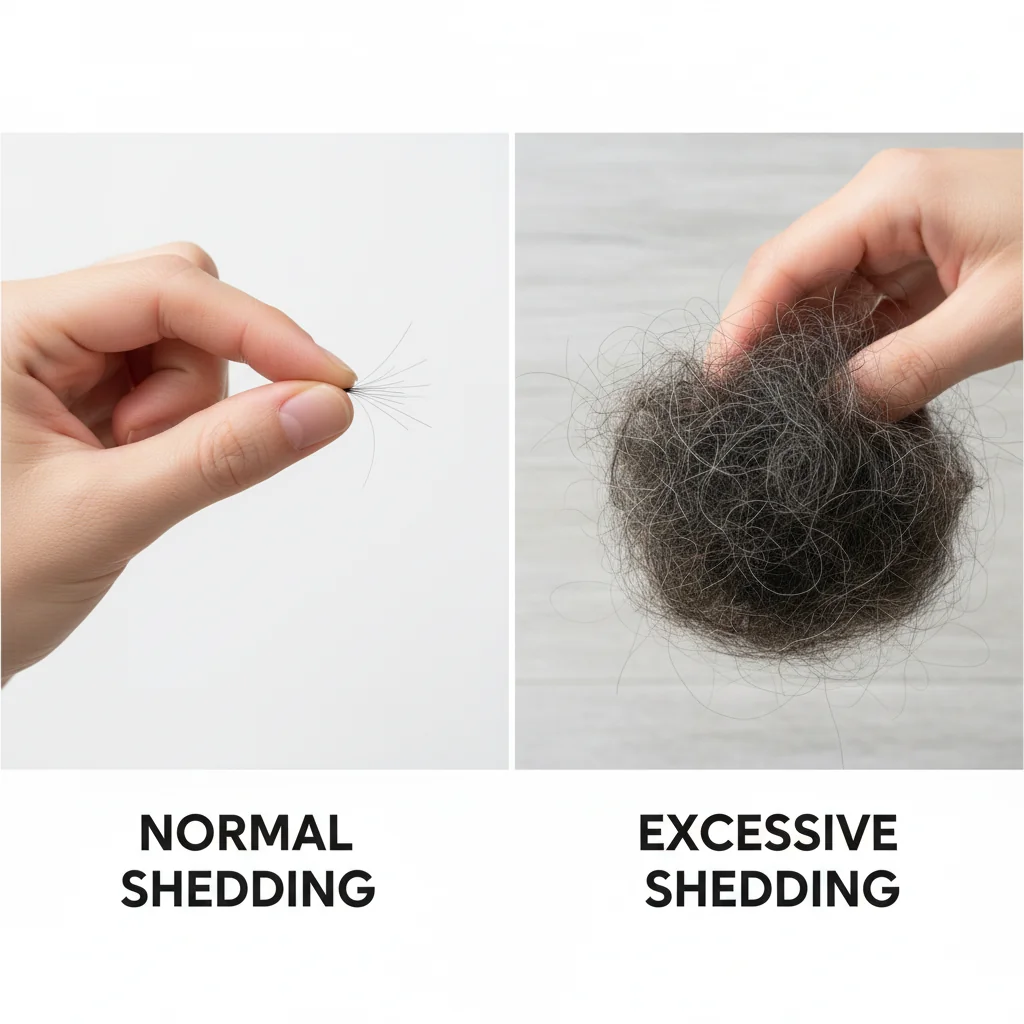customer complaints1 about shedding brushes damage your brand’s reputation and profits. You’ve invested in design and marketing, but this one flaw undermines your work. Here’s how to fix it.
To stop makeup brush shedding2, you must control the causes at the source. This means using uniform bristles, specifying harder ferrules like copper, and standardizing glue processes. In-line factory testing and clear post-purchase care instructions are also essential to reduce returns and bad reviews.
Shedding isn’t just an annoyance for your customer; it’s a direct hit to your brand’s credibility and your bottom line. I’ve seen it happen, from the factory floor to the 1-star review section. The good news is that it’s a completely solvable problem. The key is to move from hoping for quality to engineering it into your product specifications. Let’s break down exactly where shedding comes from and how you, as a brand owner, can prevent it before a single brush is ever made.
A quality makeup brush head requires around 120 strict manufacturing steps.True
According to OEM manufacturer Vonira Beauty, the complexity of brush head production means any shortcut, especially in combing, tying, or gluing, can lead to shedding.
All synthetic bristles are 100% shed-proof.False
While synthetic fibers are more uniform and less prone to breakage than natural hair, shedding can still occur due to poor glue application, a loose ferrule, or improper user care.
Why do brushes shed from the fiber, glue, and ferrule?
You see the fallout, but you don’t know the root cause. Is it the hair? The glue? The metal part? This uncertainty makes it impossible to give your manufacturer clear instructions.
Brushes shed due to a combination of factors. Natural or heavily dyed bristles can be weaker and more prone to breaking. Soft aluminum ferrules can deform, loosening the glue’s grip. And an imprecise gluing process—too little, too much, or improper curing—is a primary cause of failure.
Deeper Dive: The Anatomy of a Shedding Brush
When a brush fails, it’s rarely one single thing. It’s usually a chain reaction where one weak link compromises the entire structure. As a brand owner, understanding these failure points is the first step to creating a better product. I’ve audited countless production lines, and the problems almost always trace back to one of these three areas.
Bristle Choice and Treatment
The journey starts with the hair itself. Synthetic fibers are engineered for uniformity, so they have a lower inherent risk of breakage. Natural hair, like goat or squirrel, is beautiful but varies in thickness and strength. This is why rigorous combing to remove weak hairs is non-negotiable for natural brushes. A major factor many brands overlook is the dyeing process.
- Do black-dyed bristles shed more than undyed ones?
Yes, they often do. The chemicals used for heavy dyeing, especially to achieve a deep black, can weaken the protein structure of natural hair, making it more brittle. For a performance-focused line, I often advise my clients to consider undyed or lighter-colored bristles to minimize this risk.
The Ferrule’s Hidden Role
Think of the ferrule as the foundation of the brush head. Its only job is to hold the bristle bundle tightly so the glue can do its work.
- Which materials and ferrules shed less over time?
Harder metals like copper and brass are far superior to aluminum. Aluminum is cheaper and lighter, but it’s also soft. It can easily get dented or bent during use or cleaning, which breaks the glue seal. Copper holds its shape, ensuring the glue joint remains stable for years. For any brand building a "pro" or "luxury" line, specifying copper ferrules is one of the easiest ways to improve long-term durability.
The Science of Gluing
This is where so much goes wrong. The gluing process is a craft that requires precision and patience. The operator must inject the exact right amount of a high-quality, waterproof epoxy. Too little, and the hairs won’t be secure. Too much, and the glue wicks up into the bristles, making them stiff and causing them to snap. After gluing, the brushes must be left to cure in a temperature- and humidity-controlled environment. Rushing this step to meet a deadline is a classic cause of widespread shedding.
Black-dyed bristles can be weaker and more prone to shedding.True
Dermatological sources and factory experience confirm that the dyeing process, particularly for black, can compromise the integrity of hair fibers, increasing breakage and fallout.
Copper ferrules are more durable and provide a better seal for glue than aluminum.True
Industry suppliers like Queen Brush note that copper's hardness and corrosion resistance prevent deformation, maintaining the integrity of the glue joint and reducing long-term shedding risk.
Which factory and QC controls cut shedding?
You’ve told your factory you want "high quality," but shedding complaints keep coming in. Vague requests get vague results, leaving you feeling powerless and relying on your supplier’s word.
To truly cut shedding, your factory must implement and document specific controls. This includes multi-stage hair combing, standardized glue volumes, controlled curing times, and using harder ferrules3 with tight fit tolerances. Most importantly, they must perform in-line pull tests on samples from every single batch.
Deeper Dive: Building a Shed-Proof Sourcing Checklist
You can’t be on the factory floor every day, but your technical pack (tech pack) can be. Shifting your mindset from a buyer to a product engineer is key. Instead of asking for "good," you need to define "good" with measurable standards. When I work with new brands, we build these specifications directly into their sourcing documents. This tells the factory you are an expert client and leaves no room for interpretation.
1. Hair Prep and Bundling Specs
This is your first line of defense. Before the hairs are even bundled, they must be combed repeatedly to remove short, broken, or weak strands. A good factory tracks this.
- Your Checklist:
- Mandate a multi-stage combing process for all natural hair.
- Ask for the scrap hair ratio by raw material lot. A high ratio is a red flag.
- Specify the tension for the thread used to tie the bundle. Too tight, and it breaks hairs; too loose, and glue can leak.
2. Ferrule and Glue Engineering
This is where you prevent mechanical failure.
- Your Checklist:
- Ferrule Material: Specify "Copper" or "Brass" for premium lines. For budget lines, specify "Thick-walled Aluminum" with a specific finish like anodizing to improve hardness.
- Glue Type: Specify "Waterproof, heat-resistant two-part epoxy."
- Curing Process: Mandate a minimum curing time (e.g., 24-48 hours) in a controlled environment before packaging.
3. In-Process and Final QC Testing
This is how you verify the process worked. Don’t wait for customer complaints.
- Your Checklist:
- Pull Test: Require a pull test on a set number of brushes per 1,000 units. Define the minimum force the bristles must withstand (e.g., 2.5 Newtons).
- Wet-Aging Test: The factory must wash and dry a sample set (e.g., 5 brushes per lot) 3 times and count the shed hairs.
- Acceptance Criteria: Define the pass/fail number. For example: "After 3 wash/dry cycles, the brush must shed no more than 5 hairs to pass." If a lot fails, it must be held for investigation.
All factories automatically perform pull tests and wet-aging cycles on brushes.False
These are specific QC measures that a brand must typically request and define in their technical specifications. Not all factories include this as a standard procedure.
Specifying copper ferrules can significantly reduce long-term shedding.True
Copper's rigidity prevents the ferrule from deforming during use and washing, which protects the glue bond and keeps bristles secure over the brush's lifespan.
What post-purchase care prevents shedding?
A customer complains about shedding, but you have a strong suspicion they are washing their brushes incorrectly. You’re stuck between blaming your customer and issuing a costly replacement.
Let’s give your customers clear, simple care instructions that protect the brush from damage. This empowers them to maintain their tools properly and reduces avoidable warranty claims for your brand.
To prevent shedding, customers should use gentle cleansers with lukewarm water, keeping moisture away from the metal ferrule. Brushes must be air-dried angled downward or flat, never upright or with a hairdryer. This simple advice stops water from seeping into the glue and weakening it.
Deeper Dive: The Three Rules of Brush Care Education
Even the best-made brush can be ruined by improper care. As a brand, providing simple, visual care instructions is one of the highest-ROI things you can do. It reduces returns, improves customer satisfaction, and reinforces your brand’s position as an expert. I always tell my clients to include a small, beautifully designed care card in their packaging. It should focus on three simple rules.
Rule 1: Wash Gently, and Keep the Ferrule Dry
The number one mistake users make is soaking the entire brush head in water. This allows water to get past the crimp and into the ferrule, where it sits and slowly degrades the glue.
- Your Instruction: "Wash with a gentle brush soap and lukewarm water. Wet the bristles only, pointing them downward. Avoid getting water on the metal ferrule or wooden handle."
Rule 2: Reshape and Dry Angled Down
The second biggest mistake is drying brushes upright in a cup. Gravity pulls all the remaining moisture directly down into the glue chamber. It’s a guaranteed way to cause shedding over time.
- Your Instruction: "Gently squeeze out excess water with a towel and reshape the bristles. Lay the brush flat on a clean, dry surface with the head hanging over the edge, or dry it upside down in a brush holder. Never use a hairdryer."
Rule 3: Store in a Dry, Open Space
The final piece is storage. A damp brush stored in a sealed makeup bag or a humid bathroom is a breeding ground for bacteria and puts constant stress on the glue.
-
Your Instruction: "Store your brushes in an open-air holder, like a cup or stand, in a dry, well-ventilated area. Ensure brushes are 100% dry before storing them in any enclosed bag or case."
-
How do you fix a shedding makeup brush without replacing it?
If a brush starts shedding, the first step is to perform one perfect wash-and-dry cycle following these rules. This can sometimes "reset" a brush if the issue was just residue buildup. However, if it continues to shed after this, the problem is a manufacturing defect in the glue or ferrule fit, and it cannot be fixed. At that point, it should be replaced.
Drying brushes upright in a cup is the best method.False
Drying brushes upright allows water to seep into the ferrule, which dissolves the glue and leads to shedding. Brushes should always be dried flat or angled downward.
Using a hairdryer on a makeup brush is a safe way to dry it quickly.False
The high heat from a hairdryer can melt or weaken the glue that holds the bristles in place, causing immediate and severe shedding.
How do you tell normal vs. excessive shedding?
A customer emails you saying their new brush is "shedding a lot." You don’t know if it’s a few normal loose hairs from a new brush or a genuine product defect.
This ambiguity makes it hard to manage customer service and track real quality issues. Here is a clear checklist to help you, your team, and your customers differentiate normal initial shedding from a real problem.
Normal shedding is defined as a few loose hairs (less than 10) coming out during the first 1-2 uses or washes. This is common with dense brushes. Excessive shedding is continuous fallout after several gentle washes, bristles breaking mid-shaft, or a wobbly ferrule, indicating a defect.
Deeper Dive: Creating Your Brand’s QA Triage Checklist
Having a clear, consistent definition of "normal" vs. "excessive" is critical for your customer service team. It allows them to resolve issues confidently and helps you gather accurate data on potential product flaws.
What is "Normal" Shedding?
- Is it normal for new makeup brushes to shed?
Yes, a small amount of initial shedding is completely normal. When a dense brush head is made, some short or untethered hairs get trapped within the bundle. During the first few uses and the first wash, these loose hairs will work their way out. I call this the "blooming" period. It should stop after 1-2 gentle washes. - Your Guideline: A few hairs (5-10) on a new, dense face brush is normal. One or two hairs from a smaller eye brush is normal.
Red Flags for "Excessive" Shedding
This is what points to a true manufacturing defect. The key word is continuous.
- Your Guideline: A brush has a defect if it meets any of these criteria:
- It continues to lose multiple hairs with every use, even after 2-3 gentle washes.
- Hairs are breaking off in the middle, not coming out from the base. This signals poor quality bristles.
- The ferrule feels loose, wiggles, or spins on the handle. This indicates a failed glue joint.
- You can see visible clumps of glue on the bristles or smell a strong chemical odor.
Your Customer Service Triage Process
When a customer reports shedding, empower your team with this simple script:
- Acknowledge and Educate: "Thank you for letting us know! A few loose hairs can be normal at first. Could you please try washing it once gently with lukewarm water and drying it angled down?"
- Assess: "After it’s dry, please use it again and let us know if the shedding continues. We want to make sure your brush is perfect."
- Resolve: If the customer confirms it’s still shedding, don’t argue. Immediately process a replacement. This builds immense brand loyalty. Ask for the defective unit back so your team can inspect it and trace the lot number.
A few loose hairs on a brand new, dense powder brush is a sign of a defect.False
It's normal for some trapped, loose hairs to come out of a new, dense brush during the first few uses. This should stop after the first wash.
If a brush continues to shed after three washes, it is likely defective.True
Continuous shedding after the initial 'blooming' period indicates a failure in the glue, ferrule, or bristle quality, and it should be considered a manufacturing fault.
Frequently Asked Questions for Brand Owners
-
What’s the fastest factory lever to reduce shedding complaints?
Focus on the hardware. Upgrade your top-selling or most-complained-about SKUs to copper ferrules and implement a mandatory pull test with a defined pass/fail force. This, paired with a consumer care card, tackles both manufacturing and user error at once. -
How should our brand set "pass/fail" shed thresholds?
Establish a baseline by testing your current brushes and top competitors. Run a 3-cycle wet-aging test and count the hairs. For a dense face brush, a good goal might be "<15 hairs on first wash, <5 on second, <2 on third." Set this as the standard in your tech pack. -
Are synthetic fibers the only path to a low-shed brush?
No. High-grade natural hair can perform exceptionally well if the factory’s preparation process is rigorous. The key is demanding (and paying for) superior hair grading, combing, and bundling, along with a rock-solid ferrule and glue process. Synthetics are simply more consistent and have a lower risk from the start. -
What consumer education most reduces avoidable returns?
A simple, visual guide with three rules: "1. Wash gently with lukewarm water. 2. Dry angled down or flat. 3. Never soak the handle or use a hairdryer." This message alone can significantly cut down on user-induced shedding complaints.
Conclusion
By controlling specs from fiber to ferrule and educating customers on care, you can transform shedding from a brand liability into a mark of quality, reliability, and customer trust.
References
-
Effective complaint management can improve brand reputation and customer loyalty. ↩
-
Understanding the causes of shedding can help you improve product quality and customer satisfaction. ↩
-
Choosing the right ferrule material can significantly enhance the durability and performance of makeup brushes. ↩






